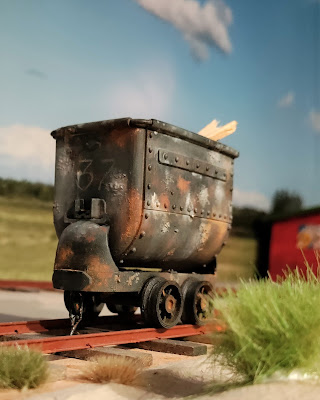After preparation of the basic ground covering with used ground coffee and sieved gravel and dirt as well as small stones and twigs, I finally pulled myself together and fired up the static grass applicator. The loading ramp segment now has a basic cover of grass in varying tones.
 |
| After a few days in my covered car parking the loading ramp segment is fully grassed. |
Before I added the static grass I placed grass tufts where I thought it was appropriate. To fasten the static grass I used glue from RTS in two variants. The best for the large areas was the 'Gras-Flock Kleber – cremig' smeared on the ground surface with a flat brush. I varied the thickness and covering of the glue hoping to create different levels of grass covering. In places I didn't add glue allowing the ground to show through.
.JPG) |
| Nystrup loco no. 3 rolling down the lorry ramp with an empty skip. The static grass in the foreground is a mix of RTS grass colours 'Early summer' and 'Straw'. |
The rear side of the segment is fitted with a predominantly dry and pale growth of grass. The front side is more green and lush. Although the grass towards the rear isn't too obvious when viewed from the front, the idea is that the lighter grass will blend better in with the photographic backdrop.
Once the glue was applied, I started with a thin layer of 4 mm high grass with the name 'Summer' from RTS. Then I added 12 mm grass in the RTS grass colours 'Early summer' and 'Straw'. Where I wanted the grass to be green and fresh, living of good quaility soil I used most of the 'Early summer' variety and where I wanted the grass to look pale and struggeling with less fertile soil I used 'Straw'.
.JPG) |
| With a basic covering of grass the layout segment begins to show some of the views I had planned. There is still much to do, though. As I worked outdoor the photos were made in my garden. |
There is a lot more to do regarding grass and shrubbery on the loading ramp segment, but first I will work on the road area below the ramp. More plank road still needs to be made as well as covering the rest of the area with a suitable mix of sieved gravel - perhaps with some waterfilled potholes for variety.

.JPG)




.jpg)





.JPG)



